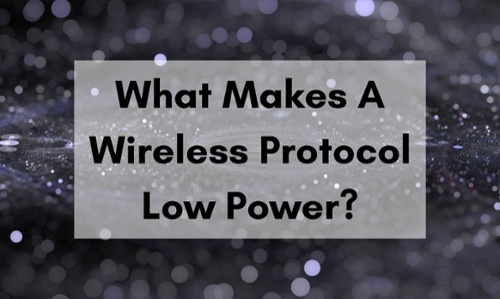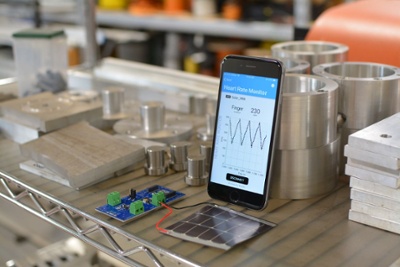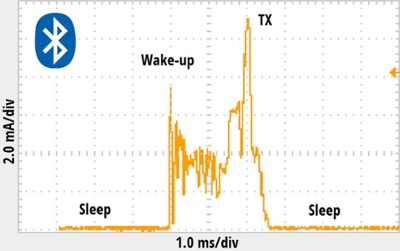What Makes A Wireless Protocol Low Power

You might be wondering why a solar company is writing about low power wireless protocols.
Well, PowerFilm is no ordinary solar company.
We manufacture thin, flexible solar material able to collect artificial light in indoor environments.
For the last 30 years, we have provided custom power solutions for low power electronics and now the emerging IoT industry.

Figure 1, PowerFilm’s Solar Development Kit with Nordic BLE (DEV-BLE-NS) Connected to the nRF Toolbox mobile app.
From this experience, we have gained a unique perspective on just what it takes to make devices low power.
Wireless devices constitute a large and growing portion of electronics. The importance of reducing the power consumption of these devices can't be overstated. Meeting the power needs of next-generation IoT applications will require a compound solution of both traditional and alternative power sources.
Truly low power devices will enable better battery life or allow devices to run indefinitely with an energy harvesting solution.
What makes a device truly low power?
First, we need to look at how a device uses energy.
Energy Formula
Wireless devices will consume different amounts of energy depending on what state they are in and how long they are in each state. In most cases, we can simplify the device's behavior into two states; sleep and active.
When a device isn't doing anything, it can nearly shut down and be put into an ultra-low power consumption ‘sleep' mode. It only wakes up and becomes ‘active' when it needs to transmit or collect more data.
To understand overall energy consumption, we can use a simple, yet powerful formula which combines power consumed while sleeping and power consumed while active.
Sleep Power × Sleep Time + Active Power × Active Time = Total Energy
This equation calculates the total energy consumed over a period of time. This could be one second, one minute, one hour, one day, or one year depending on your application.
Devices with lower data rates spend more time sleeping and less time active, thus consume less energy. Devices with lower sleep power and lower active (transmission) power also consume less energy.
Total energy consumption could be dominated by either the sleep component or the active component depending on the configuration.
BLE Example
Let's walk through an example to see how this equation can be applied in real life.
Figure 2 shows the power profile of a BLE transmission. Initially, the device draws about 5uA of current while sleeping. It then wakes up, prepares for transmission, transmits data, and goes back to sleep. This process takes only 2-3ms with an average current draw of 5mA.

Figure 2, power profile of a BLE data transmission event showing how devices wake up momentarily to transmit or collect data before returning to an ultra-low power sleep state.
Let's assume our device transmits data once every two seconds and operates using a 3V coin cell battery.
Since power = current x voltage, the energy formula would be:
3V x 0.005 mA x 2 seconds + 3V x 5mA x .003 seconds = 0.075mW•s per 2 seconds
Over 24 hours, you would need:
0.075mW•s / 2 s x 3600 s/h x 24 hours = 3240 mW•s of energy
We can convert to mWh (more commonly used units):
3240 mW•s / 3600 seconds per hour = 0.9 mWh per day
We can also convert to mAh: (current = power / voltage)
0.9mWh / 3V = 0.3 mAh per day
Each metric can be useful. Batteries tend to be rated in mAh while alternative power sources, like solar panels, tend to be rated in mWatts or Watts.
Battery life can be estimated by dividing rated capacity by daily consumption. Be cautious when relying on rated battery capacity, which is often measured at very light loads. Higher loads, like those seen during data transmissions, can significantly reduce usable battery capacity.
For a small 50mAh coin cell battery:
50mAh / 0.3mAh per day = 166 day battery life
We can also estimate what a solar energy harvesting solution would look like, which will extend battery life indefinitely. Required power output from the solar panel can be estimated by dividing daily consumption by the expected daily light exposure.
For 8 hours of dim indoor light (200 lux):
0.9mWh / 8 hours = 0.112mW Indoor Solar Panel.
In an outdoor setting, this amount of power could be generated with a solar panel smaller than a square inch.
In this example, energy consumption is almost evenly split between sleep and active modes. However, if the data rate were lowered (> 2 seconds), the sleep component would begin to dominate the equation.
If the data rate were increased (< 2 seconds), the active component would dominate.
As you can see, sleep and active components are equally important and need to be optimized to achieve a low power solution.
In general, consuming less than 1mWh of energy per day is a reasonable goal for a low power design.
Active Mode Power
Power consumption, while a device is active, will primarily depend on the protocol it uses and how its configured. Any additional sensors or components will also increase power consumption while active.
There are many popular wireless protocols with a wide variety of characteristics. In general, protocols with similar range and throughput will have similar power consumption specs. Table 1 shows transmit (TX) current and duration, sleep current, range, and throughput for several protocols.

Table 1, Comparison of power, range and throughput characteristics for popular wireless protocols sorted from lowest power consumption at the top to highest power consumption at the bottom.¹ ³ ⁴ ⁵ ⁷
The table is sorted by power consumption with lowest at the top and highest at the bottom. As we can see, protocols with shorter range and lower throughput tend to have very low power consumption. Protocols with longer range and high throughput, like your cellphone, consume large amounts of power (relatively).
Another essential thing to consider is that it takes longer for some protocols to transmit data. The cellular protocols must remain in a high power active state much longer than LoRaWAN and BLE to transmit data, which significantly increases active mode power consumption.
The good news is that low power is still possible for cellular protocols that maintain very low sleep current.
BLE, Zigbee, Z-Wave, or other short-range protocols tend to have low transmission current and low sleep current and can achieve extremely low power.
For long-range applications that only transmit small amounts of data, LoRaWAN is an excellent option that can be nearly as low power as a short-range protocol.
NB-IoT and LTE-M, explicitly developed for IoT, can take advantage of cellular infrastructure, extending their range to anywhere coverage exists. This extended range and throughput comes at the cost of higher transmission power and duration, which can be compensated for by reducing the number of transmissions per day.

Figure 3, low power cellular protocols developed to meet the performance and power needs of the emerging IoT industry.³
Other than protocol-specific characteristics, see the list at the end of this post for software and hardware tips to keep power consumption as low as possible.
Sleep Mode Power
The most significant factor affecting sleep mode power is using sleep effectively. This is done by carefully planning when a device wakes up and what it does.
Consider your use case and define the longest period (lowest data rate) possible between each data collection/transmission events. For many protocols, this is a setting that can be configured in software, or you can use a timer to define a custom data rate.
For wireless devices, many activities can be grouped and completed during the data transmission event.
Instead of having the device wake up multiple times to collect and send data, it only needs to wake up once. Even transmission events themselves can be grouped.
Figure 4 shows how multiple data packets can be sent during the same BLE transmission event, which is much more efficient.

Figure 4, Comparison of BLE transmission profiles for sending one, two and three data packets at once. Combining and sending multiple data-packets at once can be significantly more efficient.
Actual sleep current depends on what is called "quiescent" current. All hardware components have some amount of quiescent current, which represent the current they draw when they disabled, aren't being used, or are shutdown.
The total sleep current for a device is equal to the sum of the quiescent current of all its hardware components. It is usually dominated by the component with the highest quiescent current.
Modern sensors, microcontrollers, and other hardware components can typically achieve quiescent currents less 1uA.
10uA total sleep current is a reasonable goal for low power design.
Putting it All Together
So far, we have stayed at a relatively high level. We've talked about significant device behavior changes and practices that can drastically reduce power consumption.
Now it's time to go through a quick checklist of hardware and software tips to keep your device running as low power as possible. Some may be obvious, but others aren't so straight forward.
Keep in mind that many of these tips come with trade-offs, including cost, additional components, or performance.
Software
-
Adjust transmission power to match the requirements of your application. Don't transmit at 20dB if you only need 0dB to meet your range and reliability needs.
-
Disable software and hardware components while not being used (ADCs, Logs, I/O pins, external sensors, brown-out detection, timers, watchdog, unused RAM). ² ⁶
-
Adjust connection parameters to be as long as possible.⁶
-
Adjust the ‘connect' event to be as short as possible.
-
Lower clock frequencies when possible.²
-
Make sure your compiler is optimized for target performance and not debugging.⁶
-
Execute code from RAM instead of FLASH memory.⁶
Hardware
-
Know and minimize the quiescent current draw of ALL hardware components used. 10uA total sleep current is a reasonable goal for low power design.
-
Use large passive resistor values (Mohm range if possible). A 1Mohm resistor will draw 3uA from a 3V source, which is significant when compared to <1uA current draw from many microcontrollers and hardware components.
-
Lower your supply voltage as much as possible. ²
-
Use a DC-DC converter with a coil inductor instead of a linear regulator.⁶
-
Use low load capacitance external crystal oscillators, instead of internal clock sources.⁶
-
Use a single-ended antenna configuration vs dual or differential.⁸
Implementing these tips is just icing on the cake. Start with significant behavioral changes at the highest level and work your way down to the small stuff.
Consider your application requirements from a power perspective as you develop and design your product instead of addressing it as an afterthought. In many cases, low power can be achieved with minimal effect on device performance.
Creating a low power device is the first step of an energy harvesting solution.
If you want to learn more about designing low power devices that can run on solar energy harvesting, please contact us.
We would be glad to work with you in developing the next generation of self-powered IoT devices.
References
-
Huang, Junxian, et al. “A Close Examination of Performance and Power Characteristics of 4G LTE Networks.” Proceedings of the 10th International Conference on Mobile Systems, Applications, and Services - MobiSys 12, 2012, doi:10.1145/2307636.2307658.
-
Giant, Alex the. “Reducing Arduino Power Consumption.” Reducing Arduino Power Consumption, SparkFun Electronics, 9 Jan. 2015, https://learn.sparkfun.com/tutorials/reducing-arduino-power-consumption/all.
-
“Low Power Cellular IoT - Nordic Semiconductor.” Nordic Semiconductor - Home, Nordic Semiconductor, https://www.nordicsemi.com/Products/Low-power-cellular-IoT.
-
Mwakwata, Collins Burton, et al. “Narrowband Internet of Things (NB-IoT): From Physical (PHY) and Media Access Control (MAC) Layers Perspectives.” Sensors, vol. 19, no. 11, Aug. 2019, p. 2613., doi:10.3390/s19112613.
-
Aufranc, Jean-Luc, and Jean-Luc. “A Look at LoRaWAN and NB-IoT Power Consumption.” CNX Software - Embedded Systems News, CNX Software, 29 Mar. 2018, https://www.cnx-software.com/2018/03/29/a-look-at-lorawan-and-nb-iot-power-consumption/.
-
Sverrisson, Stefan. “nRF51 Series Current Consumption Guide.” Nordic DevZone, Nordic Semiconductor, 1 June 2015, https://devzone.nordicsemi.com/nordic/short-range-guides/b/hardware-and-layout/posts/nrf51-current-consumption-guide.
-
Semtech Corporation. (n.d.). Low Energy Consumption Design. Low Energy Consumption Design. Retrieved from https://www.semtech.com/uploads/documents/LoraLowEnergyDesign_STD.pdf
-
Texas Instruments. (2016). CC2650 SimpleLink™ Multistandard Wireless Mcu. CC2650 SimpleLink™ Multistandard Wireless MCU. Retrieved from http://www.ti.com/lit/ds/symlink/cc2650.pdf